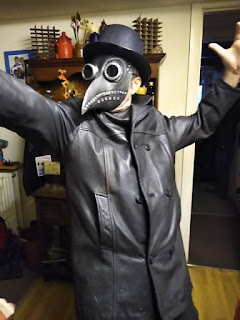Birthing Ganesha (an extract from a novel)
‘I shall swim into quiet water’—Virginia Woolf,
1940.
Portentous watery images occur repeatedly and
hauntingly towards the end of Virginia Adeline Woolf’s diaries, which run out
suddenly, shortly before she committed suicide by filling her pockets with
stones and wading out into the River Ouse: ‘wet passages … water broken, white,
roaring … may the flood last forever … wild grey water …’ The entries terminate
shortly thereafter; there would be nothing further. That channel was now dead.
If one
were to ask our Adeline how she had chosen her name at the age of
sixteen (as is the tradition these days), she might well cite as influential
these diaristic references with their suggestion of a dark prescience. Perhaps
she wanted to be a larger-than-life literary seeress immortalised in a mythic
death scene (for who truly does not want to be a superhero like that?). And of
course Adeline—like anyone sufficiently Romantic—wondered what might have come
next in that truncated diary if Virginia Adeline Woolf had lived to tell the
tale. It was, she thought in later life, somehow similar to Paul Cézanne’s
final order of oils arriving a day or two after his death in 1906. What might
those paints have become? Certainly Pablo Picasso—who called Cézanne ‘the
father of us all’—would have wished to know, and, like Adeline, will have
mourned for what might have been.
Riley
definitely wants to be a comic-book superhero; he wants this so much that he
has now dissociated to the point where he is almost no longer real outside of
his fictional self. Perhaps he is now only a character in a sort of
graphic novel without pictures. But, however much he may have lost or gained in
this transmutation, this is not a story about Riley, who waits, frozen in his
charcoal shadow, for some possible future revival: this is a story about
Adeline, who, in another life, allegedly bore splashing witness to a remarkable
and divine metamorphosis—perhaps a birthing.
(A lost valley, somewhere in the flooded blue jungles
of southern India.)
This happened on Adeline’s eighteenth birthday,
just a few weeks after she killed her father with a spade (of which there will
be no mention here). She was a mycology student back then, on a field trip to
India to study the fungi of the Subcontinent, which has, after all, one third
of all the fungal diversity of the world, much of it still undescribed and
unclassified.
It was
a place of rearing elephantine baobab trees, of giant arboreal tigers, many of
them white as Siberians, almost as big as elephants, curled like freakish
housecats in their high nests. (One hears them growling from above, but they seldom
attack in such narrow daylight.)
Blood
glistened upon the jungle-water, attracting freshwater sharks and zombie-catfish;
smoke drifted through the trees, rising like a spectral offering to the gods
above the thick canopy. Adeline had arrived in the wrong season, as the forest
was currently drowned to a depth of three or four feet. There would be no
discoveries of nameless toadstools on this expedition, but anyway and
undeterred she came, lurching in her ornate howdah at the head of the
procession, riding a huge Asiatic elephant bedecked.with silks and gems.
And so
she splashed through the shark-infested shallows, through the drowsing trees,
through the pillars of green sunlight, and all the air mad with birdsong and
huge dragonflies, into the lost valley beyond.
‘I
seen a horsefly,’ sang Adeline gaily. ‘I seen a dragon fly; I seen a housefly …
but I be done seen about everything …’
But then,
as the Tiffin hour approached, what was that scent of blood and fire? Adeline
pulled up her mount, signalling the caravan to halt.
‘Nillisi, nanna prītiya ānegaḷu!’ she cried in hushed
and urgent tones, in Kannada, the elephant tongue, raising her hand like
a trunk, waving her pith helmet aloft.
And Adeline
and her company peered through the trees to behold a great wonder.
There
in a ghost-glade was a blue boy, perhaps fourteen years old, no more, blithely sawing
off his own head with a large, curved knife. Rolling in the water beside him
was another head, that of a juvenile elephant, leaching blood and ichor into
the smoky ripples, for it seemed that the water itself was somehow alight. And
as Adeline watched, the slender, straight-limbed, headless youth—vivid as lapis
from the haunted mines of Shortugai and Sar-i Sang—with all seeming unconcern,
lifted that great head by the tusks and placed it where his own had been,
whereupon it seemed that it miraculously attached itself and became alive again,
though now it was half boy.
And
this was the legendary moment of the birthing of Ganesha, god of wisdom and words,
deva of science and art, patron of new beginnings and humble hopes.
And so
Ganesha, mighty Lord of Bananas, Spouse of the Speaking Tree, there amidst the
steaming waters, danced and splashed himself to life before ascending on
invisible wings into the shimmering upper air.
And
the date thereof was the twenty-second day of the eighth month, which is
hereafter laid down in the law as holy and inviolate.
And
Adeline and her yawing équipage retreated then in fear and wonderment,
back to lesser lives, nevermore to speak or think of such marvels.
.








